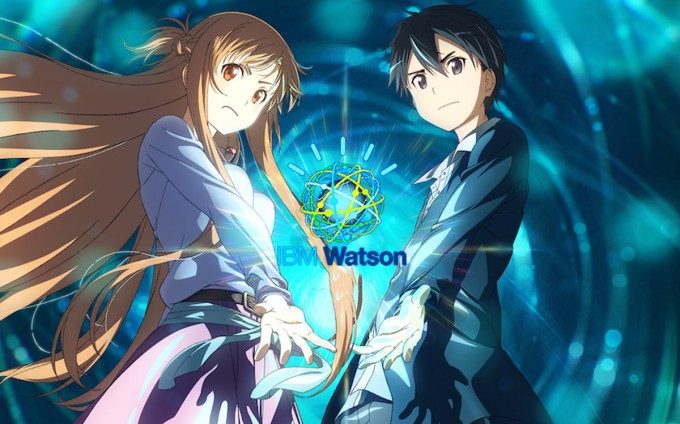As much as I want to get swept away into a VR MMO based on Sword Art Online with the rest of you, the recently announced Sword Art Online: The Beginning (involving IBM’s Watson) is not going to be the game to do it. In fact, it isn’t a game at all.
It’s been widely reported [1, 2, 3, 4, 5, 6] that the recently announced Sword Art Online: The Beginning is an actual virtual reality MMO game that’s in development, sponsored by IBM Watson, and that 208 lucky people selected to participate in an event in Tokyo in March will see a glimpse of the game’s “Alpha”. The narrative reported by most outlets is that this is an honest to goodness in-development title that will be created and released as a virtual reality MMO game. In comment threads across the web, these reports sparked waves of rejoice, promises to never leave the virtual world, and even debates about how long the full game would take to develop.
This is wrong and I’m terribly sorry to be the one that has to dash your hopes and dreams.


I can understand why people got it wrong. First of all we have the language barrier, which is a highly effective filter of nuance (which is very important to this story). Second, the entire notion of the Sword Art Online: The Beginning is a purposeful intermingling of the fictional universe of Sword Art Online and our real world. Without the context of the show itself and an understanding of virtual reality, it would be easy to misunderstand, even if you were a native Japanese speaker.
So what is it then? Sword Art Online: The Beginning is a 20 minute VR marketing demo. It is a neat marketing stunt for both IBM Watson and the Sword Art Online anime/manga/movie. It is not a game or an MMO, or anything that has legs beyond being a promotional vehicle.
How do I know? Ugh… this is going to get really meta. To try to make this easier for all of us, I’m going to use Sword Art Online to refer to the real life media property (anime/manga), and Sword Art World to talk about the fictional virtual reality game that exists within the Sword Art Online universe. Here we go.


In Sword Art Online, people in the year 2022 use a VR system called NerveGear to access Sword Art World. Within the story’s narrative, Sword Art World has just exited Beta (this is important), and players are shown joining the game on launch day. Many of the players playing on launch day were Beta players, so they know more about the game than new players. This difference between Beta players and new players becomes an important point of conflict in the plot.
While playing Sword Art World on launch day, the players get trapped inside due to someone tampering with their NerveGear headsets, which inhibit their brainwaves while they are inside the game, making them unable to move in the ‘real’ (fictional) world. If someone takes the headset off of them in the ‘real’ world, they die. So they are stuck.
What most of the media misunderstood when reporting news of Sword Art Online: The Beginning was that the ‘Alpha’ that is referenced is not an ‘Alpha’ in the game design sense. It is an ‘Alpha’ in the fictional sense—it is (according to the marketing narrative) the prequel to the fictional ‘Beta’ of Sword Art World (the version of the game that precedes players getting stuck in the game).
Update 2/25/16 7:46PM PT: Several readers have pointed out a mistake in the original article which said that the version of the game players are playing in the show is the Beta. The Beta does play an important part in the story, but the players in the game are actually shown playing on the first day of the game’s launch after the Beta. The above has been corrected to make this clear.
We can see more evidence of this in other parts of the promotional material. It is said that a certain Dr. Akihiko Kayaba has met with an IBM Researcher who, through Watson, has made the ‘Alpha’ possible. Dr. Kayaba, however is not a real person, he is a character in Sword Art Online who, inside the show, creates Sword Art World and the fictional NerveGear VR system.
See, we are mixing the fiction and non-fiction worlds. And it’s all in good fun, but so terribly easy to misunderstand without the context of the show, especially when there’s a language barrier involved.
Outside of these fiction/non-fiction interminglings, there’s more evidence that this isn’t a real MMO or even a game that will be released beyond this marketing event. The experience is not being created by a game design studio, but instead it’s being developed by an independent creative agency (with the very confusing name of 1→10), which has previously created a VR marketing experience for Pepsi.
To confirm all of this (after all, I am working from translations myself), I spoke with Shun Kubota, Editor in Chief of Mogura VR, the leading virtual reality publication in Japan. He confirmed that the marketing concept behind Sword Art Online: The Beginning is to show “what it would be like when the cognitive computing IBM is developing is used in future gaming technology.”
“So it is not actually a real game in development, it is just a marketing experience to show off VR, IBM Watson, and Sword Art Online?” I asked. “Exactly,” Kubota told me.
Update 3/1/16 12:56AM PT: While we were unable to get in touch with anyone directly involved in the project for comment, The Verge, prompted by our story, was able to reach a spokesperson from IBM who further confirmed that Sword Art Online: The Beginning is a short VR marketing experience and not the production of a real VR MMO.
So what are those 208 people going to see when they see the “Alpha’? They’re seeing a finished (not ‘alpha’) ~20 minute marketing experience (timing per the FAQ) that will involve Watson in some way (likely for NPC interaction). Players will be scanned to have their avatars in the experience and there may be some multiplayer happening but it will be something like four players at a time, far short of the scope of a real MMO.
The 20 minute ‘Alpha’ will happen over three days in March. At only 20 minutes long, if all 208 players experienced it at once (as you would suspect from a real MMO), there would be no need for three days. The official site specifies that each daily session will run from 11AM to 7PM; let’s assume there’s 10 minutes between demos: that’s 360 minutes (6 hours) running the demo each day (1080 minutes total). To fit 208 players into this time frame at 20 minutes each, the most fitting group size would be four players at a time.
We’ve actually seen something almost identical before. Back at Anime Expo 2014 Oculus showed a Sword Art Online VR experience at their booth. But then, just as now, it was a short, fun VR experience which gave players a scripted glimpse into the fiction of Sword Art World, not a real VR game being developed for release, or anything close to it.
Sorry, Internet, but our VR MMO is in another castle.

